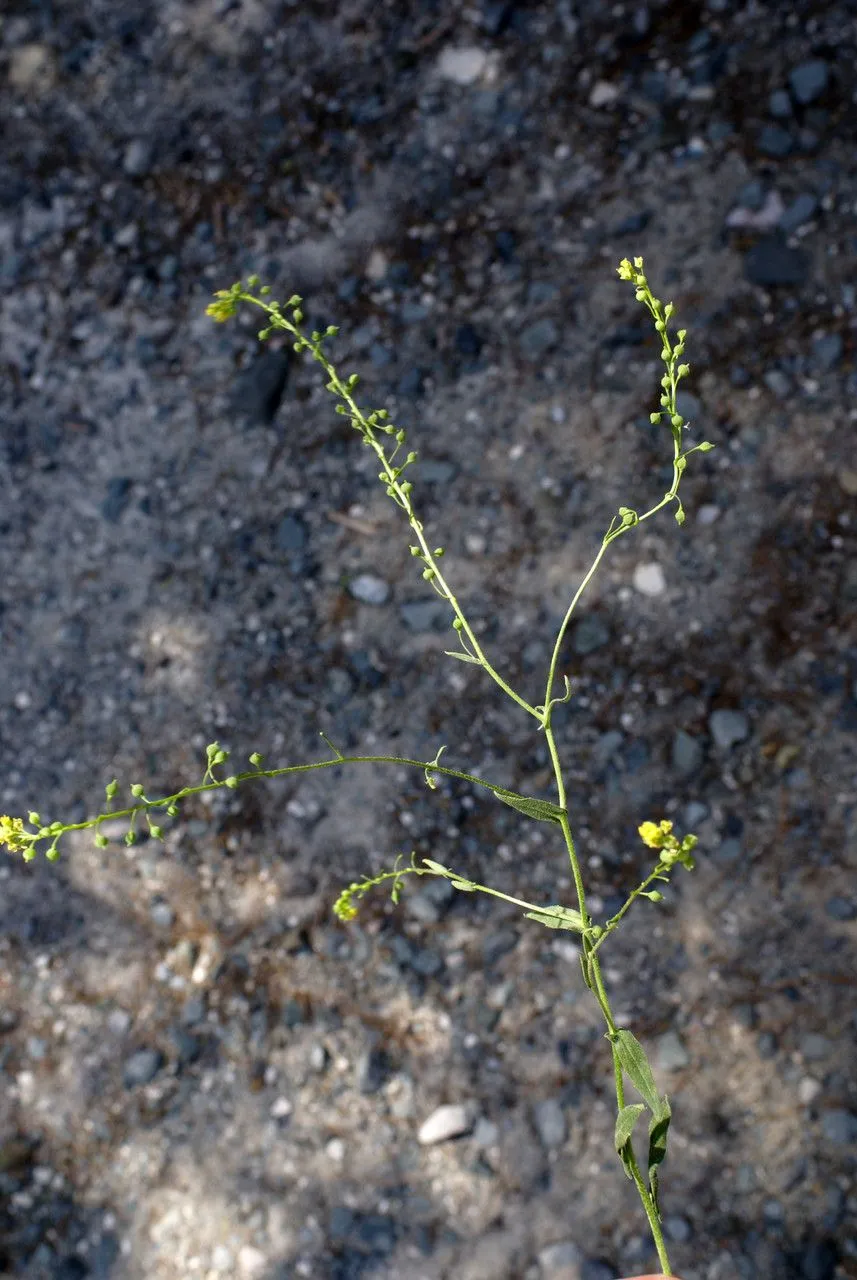
Author: (L.) Desv.
Bibliography: J. Bot. Agric. 3: 162 (1815)
Year: 1815
Status: accepted
Rank: species
Genus: Neslia
Vegetable: False
Observations: Europe to Russian Far East and N. China
Ball mustard, scientifically known as Neslia paniculata, is a fascinating specimen within the Brassicaceae family. This annual herb is native to a wide range spanning from Europe to the Russian Far East and northern China, showcasing its adaptability to diverse climates and regions.
The first comprehensive documentation of Neslia paniculata was published in the Journal of Botany and Agriculture in 1815, where it appeared under the authorship of (L.) Desv. This early 19th-century record laid the groundwork for subsequent studies and understanding of the plant.
Ball mustard is known for its small, spherical seeds that resemble miniature balls, which is how it earned its common name. The plant typically grows in open, disturbed areas such as fields and roadsides, often becoming locally abundant. The flowers are characteristic of the Brassicaceae family, with four-petaled yellow blooms arranged in a raceme pattern.
Despite its modest appearance, Neslia paniculata plays an important role in its natural habitat. It serves as a food source for various insects and can be an indicator of soil health. Although generally not considered a major agricultural pest, it can sometimes become a weed in cultivated fields, competing with crops for resources.
In terms of morphology, ball mustard exhibits a slender, erect stem that can reach heights of up to 60 centimeters. The leaves are narrow and lanceolate, providing a delicate backdrop to the brighter clusters of flowers. As the season progresses, these flowers give way to seed pods that disperse to propagate future generations.
Overall, Neslia paniculata stands as a testament to the diversity and resilience of the Brassicaceae family, thriving across a vast geographical expanse and adapting to various environmental conditions. Its early documentation and continuous study highlight its ecological significance and the ongoing interest in its biological characteristics.
Dan: almindelig rundskulpe, druebregne, dværg-gåsefod, rundskulpe, vild agurk
Eng: ball mustard, ballmustard, yellow ball-mustard, ball-mustard, common ball-mustard, paniculate ball-mustard
Deu: finkensame, gewöhnlicher finkensame, rispen-finkensame
Swe: plantanmålla, pygmémålla, pärlbräken, korndådra
Nor: daadre
Est: põld-lonnutuder
Ces: repinka metlinatá, řepinka latnatá
Nld: vinkenzaad
Fra: neslie paniculée, neslie en panicule, neslie à panicule
Cym: cedw crwn, neslia bellennog
En: Ball mustard, Ballmustard, Yellow ball-mustard, Ball-mustard, Common ball-mustard, Paniculate ball-mustard
Cs: Repinka metlinatá, Řepinka latnatá
Da: Almindelig rundskulpe, Druebregne, Dværg-gåsefod, Rundskulpe, Vild agurk
Nl: Vinkenzaad
Et: Põld-lonnutuder
Fr: Neslie paniculée, Neslie en panicule, Neslie à panicule
De: Gewöhnlicher Finkensame, Finkensame, Rispen-Finkensame
No: Daadre
Sv: Korndådra, Plantanmålla, Pygmémålla, Pärlbräken
Cy: Cedw Crwn, Neslia Bellennog
© copyright of the Board of Trustees of the Royal Botanic Gardens, Kew.
© copyright of the Board of Trustees of the Royal Botanic Gardens, Kew.
© copyright of the Board of Trustees of the Royal Botanic Gardens, Kew.
Taken May 23, 2017 by Tela Botanica − Marie PORTAS (cc-by-sa)
Taken Jun 22, 2009 by EOL − Michael Kesl (public)
Taken May 1, 2016 by Tela Botanica − Denis FILOSA (cc-by-sa)
Taken Apr 14, 2018 by Tela Botanica − Liliane ROUBAUDI (cc-by-sa)
Taken Apr 14, 2018 by Tela Botanica − Liliane ROUBAUDI (cc-by-sa)
Taken Apr 13, 2018 by Tela Botanica − Genevieve BOTTI (cc-by-sa)
Taken Apr 28, 2017 by Tela Botanica − Denis FILOSA (cc-by-sa)
Taken Apr 14, 2018 by Tela Botanica − Liliane ROUBAUDI (cc-by-sa)
Taken Apr 14, 2018 by Tela Botanica − Liliane ROUBAUDI (cc-by-sa)
Taken Apr 14, 2018 by Tela Botanica − Liliane ROUBAUDI (cc-by-sa)
Taken May 23, 2017 by Tela Botanica − Marie PORTAS (cc-by-sa)
Taken Apr 28, 2017 by Tela Botanica − Denis FILOSA (cc-by-sa)
Taken Jun 27, 2020 by Elias Villiger (cc-by-sa)
Taken Apr 14, 2018 by Tela Botanica − Liliane ROUBAUDI (cc-by-sa)
Taken May 10, 2006 by Tela Botanica − Liliane ROUBAUDI (cc-by-sa)
Taken May 23, 2017 by Tela Botanica − Marie PORTAS (cc-by-sa)
Taken Jun 27, 2020 by Elias Villiger (cc-by-sa)
Taken May 10, 2006 by Tela Botanica − Liliane ROUBAUDI (cc-by-sa)
Taken Apr 14, 2018 by Tela Botanica − Liliane ROUBAUDI (cc-by-sa)
Taken Apr 14, 2018 by Tela Botanica − Liliane ROUBAUDI (cc-by-sa)
Taken May 6, 2018 by Sergio Moliner (cc-by-sa)
Taken May 15, 2006 by Photoflora – Benoit BOCK (©)
Taken May 15, 2006 by Photoflora – Benoit BOCK (©)
Taken May 15, 2015 by Photoflora – Benoit BOCK (©)
Taken Aug 15, 2013 by Photoflora – Benoit BOCK (©)
Taken May 15, 2006 by Photoflora – Benoit BOCK (©)
Taken Apr 15, 2012 by Photoflora – Benoit BOCK (©)
Taken Jan 1, 1970 by Photoflora – L’Abbé COSTE (©)
Growth habit: Forb/herb
Family: Myrtaceae Author: (F.Muell.) K.D.Hill & L.A.S.Johnson Bibliography: Telopea 6: 402 (1995) Year: 1995 Status:…
Family: Rubiaceae Author: Pierre ex A.Froehner Bibliography: Notizbl. Bot. Gart. Berlin-Dahlem 1: 237 (1897) Year:…
Family: Sapindaceae Author: Koidz. Bibliography: J. Coll. Sci. Imp. Univ. Tokyo 32(1): 38 (1911) Year:…
Family: Asteraceae Author: A.Gray Bibliography: Pacif. Railr. Rep.: 107 (1857) Year: 1857 Status: accepted Rank:…
Family: Fabaceae Author: Medik. Bibliography: Vorles. Churpfälz. Phys.-Ökon. Ges. 2: 398 (1787) Year: 1787 Status:…
Family: Aspleniaceae Author: (Cav.) Alston Bibliography: Bull. Misc. Inform. Kew 1932: 309 (1932) Year: 1932…